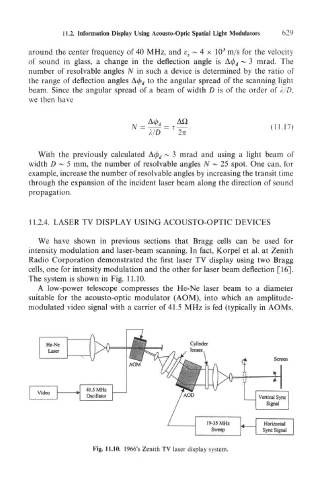Page 645 - Introduction to Information Optics
P. 645
11.2. Information Display Using Acousto-Optic Spatial Light Modulators 629
3
around the center frequency of 40 MHz, and v s ~ 4 x 10 m/s for the velocity
of sound in glass, a change in the deflection angle is A0 d ~ 3 mrad. The
number of resolvable angles N in such a device is determined by the ratio of
the range of deflection angles A<^> d to the angular spread of the scanning light
beam. Since the angular spread of a beam of width D is of the order of /ID,
we then have
(11.
/./D
With the previously calculated A^ d ~ 3 mrad and using a light beam of
width D ~-5 mm, the number of resolvable angles N ~ 25 spot. One can, for
example, increase the number of resolvable angles by increasing the transit time
through the expansion of the incident laser beam along the direction of sound
propagation.
11.2.4. LASER TV DISPLAY USING ACOUSTO-OPTIC DEVICES
We have shown in previous sections that Bragg cells can be used for
intensity modulation and laser-beam scanning. In fact, Korpel et al. at Zenith
Radio Corporation demonstrated the first laser TV display using two Bragg
cells, one for intensity modulation and the other for laser beam deflection [16].
The system is shown in Fig. 11.10.
A low-power telescope compresses the He-Ne laser beam to a diameter
suitable for the acousto-optic modulator (AOM), into which an amplitude-
modulated video signal with a carrier of 41.5 MHz is fed (typically in AOMs,
Cytttdet
lenses.
Screen
19.35MHz 4_ — Horizontal
Sweep Sync Signal
Fig. 11.10. 1966's Zenith TV laser display system.

